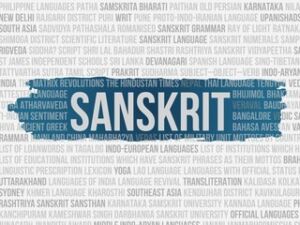1)Basic
The basic level of learning Sanskrit is starts from beginning:
Sanskrit Beginners 1 introduces the learner to Sanskrit as a linguistic system, by putting it in its appropriate linguistic context and looking carefully at how it is structured both in terms of its sound system and its grammar. The course presupposes no knowledge of an Indian language or of Latin or Greek. Sanskrit Beginners 1 first establishes a familiarity with the pronunciation of Sanskrit and the association between sounds, the transliteration system (the IAST) and the Devanāgarī. Grammatical terminology is gradually incorporated, giving the student confidence in identifying parts of speech in Sanskrit before tackling grammar. There is a mid-term session, consolidating the first half, and an end-of-term consolidation session, concentrating on the material covered in the second half of the term. At the end of the term, the student is able to read and understand basic sentences in the present tense (and the active voice), can read Sanskrit script, albeit with some difficulty and with frequent recourse to transliteration, and will have acquired a vocabulary of around 150 words.
Sanskrit Beginners 2 builds directly on Beginners 1, expanding the student’s ability to read and write the Devanāgarī script and to understand basic sentence construction. New declensional types are explored and pronouns (demonstrative and relative) are introduced. There is an emphasis on reading and understanding short, graded texts that are abridged versions of the Hitopadeśa (a collection of fables belonging to the large body of ‘wisdom literature’ in Sanskrit). Two reading passages within the term are abridged versions of fables from the Hitopadeśa. By the end of this term of study, students will have a vocabulary range of around 300 words. As with Sanskrit Beginners 1, there is a mid-way consolidation point, allowing for revision on areas that students have identified as difficult or problematic. There is also a consolidation session at the end of the term taking the form of a quiz concentrating on the material covered in Sanskrit Beginners 1 and 2.
Sanskrit Beginners 3 is a natural continuation of Sanskrit Beginners 1 and 2, devoted to building familiarity with basic Sanskrit constructions. The working vocabulary is extended to around 450 words, allowing access to short texts of greater linguistic sophistication than in previous terms. There is a strong emphasis on developing learning strategies in terms of being able to grasp declensional patterns and also the theoretical bases of conjugation. The reading of texts continues to serve as the means by which vocabulary and grammatical usage are explored. Important and widely used constructions are investigated (such as the locative absolute) and there is, as in Sanskrit Beginners 1 and 2, time factored in for consolidation.
2)Advanced
The Advanced Sanskrit Language Minor is for students who already have a high level of competence in Sanskrit. It deepens students’ knowledge and critical understanding of Sanskrit language and its associated culture. The courses included in this Advanced Minor balance the traditional practice of textual reception—reading and grammar—with language production—chanting and singing. By its completion, students will be able to independently read texts from a wide range of genres, and will be able to chant and recite with a high degree of accuracy.
Learning Outcomes
- Translate the texts at hand with a high level of competence in using a Sanskrit-English dictionary;
- Demonstrate thorough understanding of the advanced grammatical structures employed in Sanskrit, and demonstrate expertise in using reference grammars;
- Appraise the linguistic registers of the root texts, and their place among the various genres of Sanskrit literature, and reflect this in appropriate English translation. Respond creatively to the root text in an appropriate medium;
- Demonstrate an ability to interpret commentarial texts, showing an understanding of commentarial techniques and vocabulary;
- Demonstrate knowledge of the social and historical contexts of text at hand.





